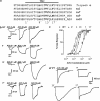Key roles of hydrophobic rings of TM2 in gating of the alpha9alpha10 nicotinic cholinergic receptor
- PMID: 15895110
- PMCID: PMC1576203
- DOI: 10.1038/sj.bjp.0706224
Key roles of hydrophobic rings of TM2 in gating of the alpha9alpha10 nicotinic cholinergic receptor
Abstract
We have performed a systematic mutagenesis of three hydrophobic rings (17', 13' and 9') within transmembrane region (TM) 2 of the alpha9alpha10 nicotinic cholinergic receptor (nAChR) to a hydrophilic (threonine) residue and compared the properties of mutant receptors reconstituted in Xenopus laevis oocytes. Phenotypic changes in alpha9alpha10 mutant receptors were evidenced by a decrease in the desensitization rate, an increase in both the EC(50) for ACh as well as the efficacy of partial agonists and the reduction of the allosteric modulation by extracellular Ca(2+). Mutated receptors exhibited spontaneous openings and, at the single-channel level, an increased apparent mean open time with no major changes in channel conductance, thus suggesting an increase in gating of the channel as the underlying mechanism. Overall, the degrees of the phenotypes of mutant receptors were more overt in the case of the centrally located V13'T mutant. Based on the atomic model of the pore of the electric organ of the Torpedo ray, we can propose that the interactions of side chains at positions 13' and 9' are key ones in creating an energetic barrier to ion permeation. In spite of the fact that the roles of the TM2 residues are mostly conserved in the distant alpha9alpha10 member of the nAChR family, their mechanistic contributions to channel gating show significant differences when compared to other nAChRs. These differences might be originated from slight differential intramolecular rearrangements during gating for the different receptors and might lead each nAChR to be in tune with their physiological roles.
Figures






Similar articles
-
Key role of the TM2-TM3 loop in calcium potentiation of the α9α10 nicotinic acetylcholine receptor.Cell Mol Life Sci. 2024 Aug 9;81(1):337. doi: 10.1007/s00018-024-05381-2. Cell Mol Life Sci. 2024. PMID: 39120784 Free PMC article.
-
Contribution of valine 7' of TMD2 to gating of neuronal alpha3 receptor subtypes.J Neurosci Res. 2006 Dec;84(8):1778-88. doi: 10.1002/jnr.21085. J Neurosci Res. 2006. PMID: 17044037
-
Tryptophan substitutions reveal the role of nicotinic acetylcholine receptor alpha-TM3 domain in channel gating: differences between Torpedo and muscle-type AChR.Biochemistry. 2004 Jan 13;43(1):78-84. doi: 10.1021/bi0356496. Biochemistry. 2004. PMID: 14705933
-
Neuronal Nicotinic Acetylcholine Receptor Structure and Function and Response to Nicotine.Int Rev Neurobiol. 2015;124:3-19. doi: 10.1016/bs.irn.2015.07.001. Epub 2015 Aug 21. Int Rev Neurobiol. 2015. PMID: 26472524 Free PMC article. Review.
-
Rational understanding of nicotinic receptors drug binding.Curr Top Med Chem. 2004;4(6):645-50. doi: 10.2174/1568026043451177. Curr Top Med Chem. 2004. PMID: 14965300 Review.
Cited by
-
Stoichiometry of the alpha9alpha10 nicotinic cholinergic receptor.J Neurosci. 2005 Nov 23;25(47):10905-12. doi: 10.1523/JNEUROSCI.3805-05.2005. J Neurosci. 2005. PMID: 16306403 Free PMC article.
-
Modeling interactions between voltage-gated Ca (2+) channels and KCa1.1 channels.Channels (Austin). 2013 Nov-Dec;7(6):524-9. doi: 10.4161/chan.25867. Epub 2013 Jul 31. Channels (Austin). 2013. PMID: 23928916 Free PMC article.
-
When is a hydrophobic gate not a hydrophobic gate?J Gen Physiol. 2022 Nov 7;154(11):e202213210. doi: 10.1085/jgp.202213210. Epub 2022 Oct 26. J Gen Physiol. 2022. PMID: 36287215 Free PMC article.
-
The α9α10 nicotinic acetylcholine receptor: a compelling drug target for hearing loss?Expert Opin Ther Targets. 2022 Mar;26(3):291-302. doi: 10.1080/14728222.2022.2047931. Epub 2022 Mar 7. Expert Opin Ther Targets. 2022. PMID: 35225139 Free PMC article. Review.
-
Virally mediated enhancement of efferent inhibition reduces acoustic trauma in wild-type murine cochleas.Mol Ther Methods Clin Dev. 2025 Mar 21;33(2):101455. doi: 10.1016/j.omtm.2025.101455. eCollection 2025 Jun 12. Mol Ther Methods Clin Dev. 2025. PMID: 40236498 Free PMC article.
References
-
- AKABAS M.H., KAUFMANN C., ARCHDEACON P., KARLIN A. Identification of acetylcholine receptor channel-lining residues in the entire M2 segment of the alpha subunit. Neuron. 1994;13:919–927. - PubMed
-
- BERTRAND D., GALZI J.L., DEVILLERS-THIERY A., BERTRAND S., CHANGEUX J.P. Stratification of the channel domain in neurotransmitter receptors. Curr. Opin. Cell Biol. 1993;5:688–693. - PubMed
-
- BERTRAND S., DEVILLERS-THIERY A., PALMA E., BUISSON B., EDELSTEIN S.J., CORRINGER P.J., CHANGEUX J.P., BERTRAND D. Paradoxical allosteric effects of competitive inhibitors on neuronal alpha7 nicotinic receptor mutants. NeuroReport. 1997;8:3591–3596. - PubMed
Publication types
MeSH terms
Substances
LinkOut - more resources
Full Text Sources
Miscellaneous

